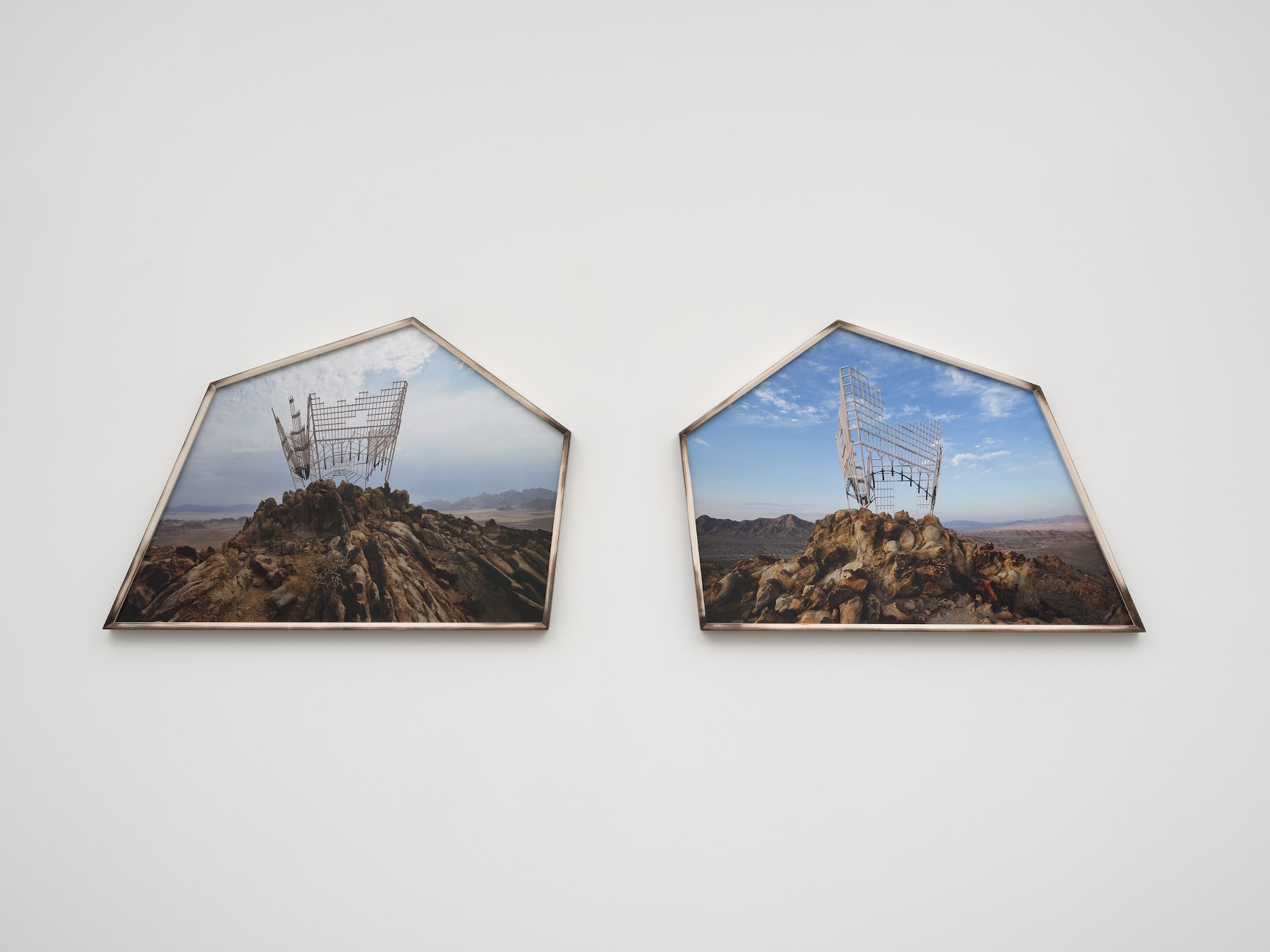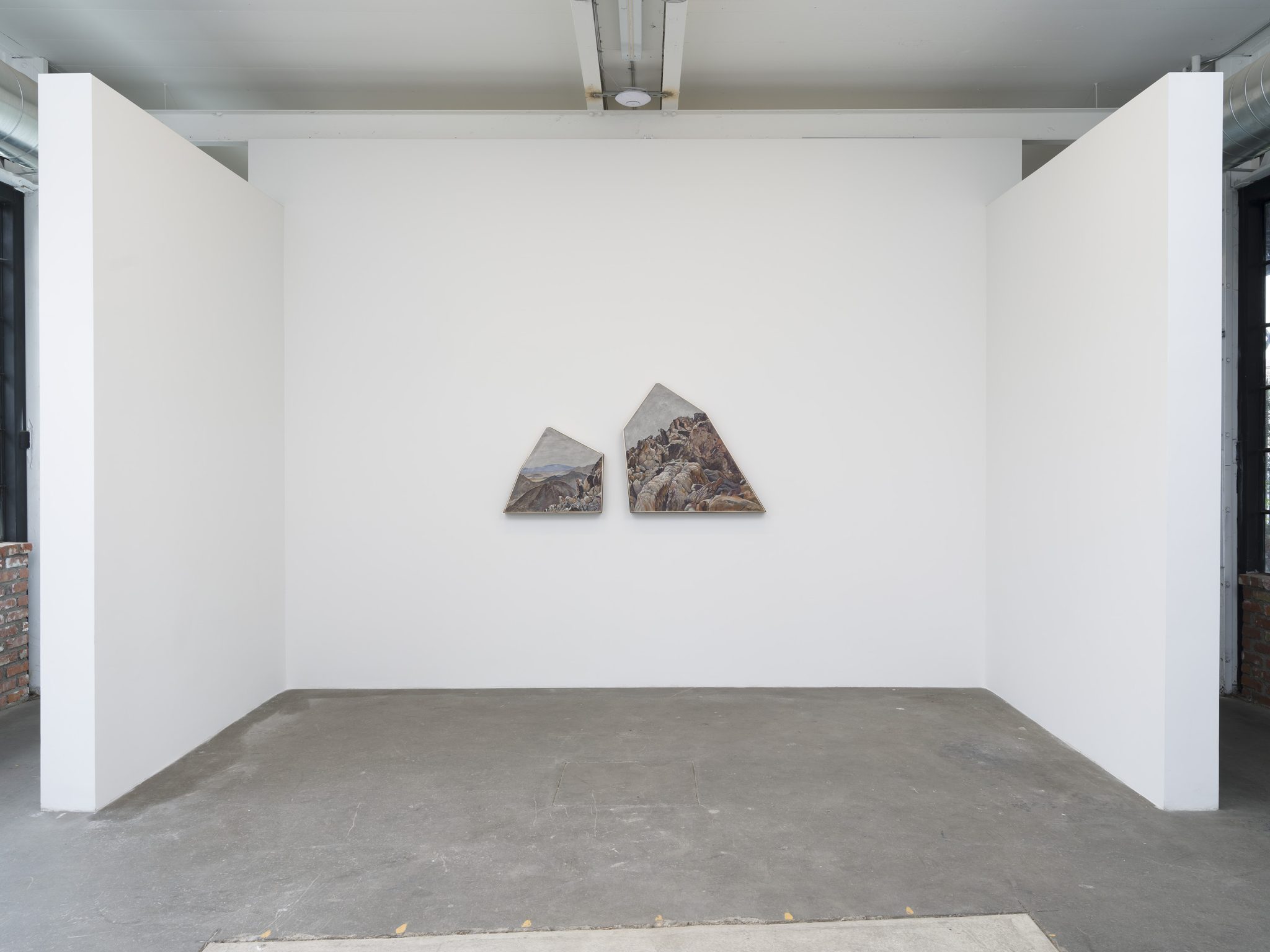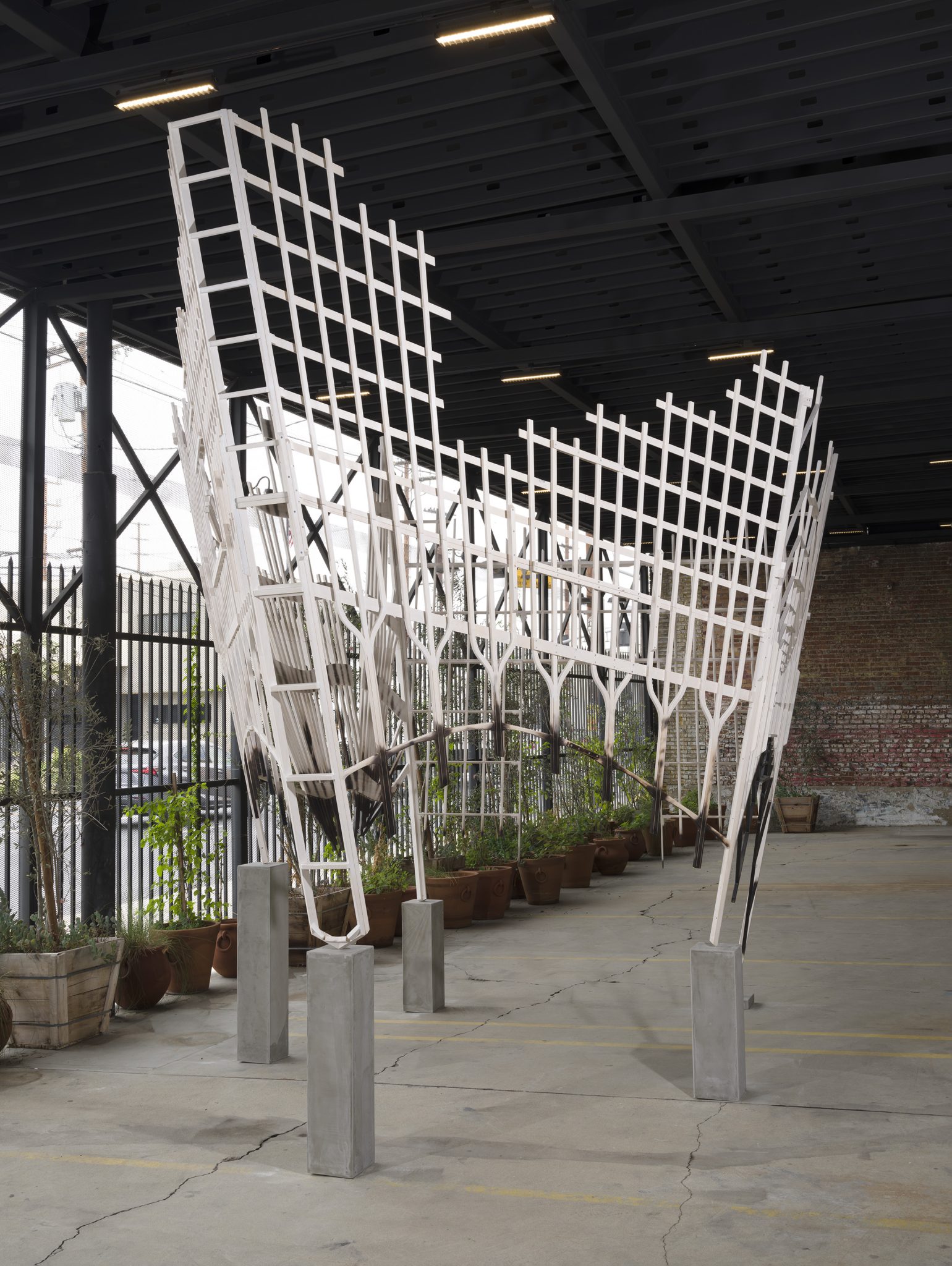

Vielmetter Los Angeles is pleased to present Akedah Altar, a solo exhibition of new works by Gregory Michael Hernandez on view from May 21 through July 2 in the Greenhouse Gallery.
Text by Julian Myers-Szupinska
Akedah Altar is a suite of artworks intimately connected with the desert as a physical place and a space of cultural inscription—as a place where nature and geology are laid bare, and where systems of power operate in their most naked form. The works draw on the role of the desert in religious traditions, including the sensibilities of the Protestant settlers that traversed the American West in the 19th century, for whom it represented a space of exile and radical exteriority, if not Hell itself. “That merciless old-time religion on which I had been raised,” wrote the historian and critic Reyner Banham, “was crammed with desert imagery.”
Raised in the Christian faith, Gregory Michael Hernandez now describes himself as a Christian atheist, a contradiction-in-terms that accounts for the moral seriousness and existential crisis that inflects his work. So too does it direct the viewer to the matters of ritual, sacrifice and collective suffering that frame the paintings and sculpture on view. The central artwork of this ensemble is a complex wooden construction that invokes destroyed architecture—it transcribes the ruins of the World Trade Center after the attacks of September 11, 2001—and the volatile forms of constructivist monumentality after the Russian Revolution.
The sculpture is, as Hernandez describes it, a relic of a performance, one that addressed the biblical narrative of the Akedah, a Hebrew word meaning “binding.”
What was the Akedah? The word relates to a passage in Genesis 22. There, God commands Abraham to take his son Isaac to Moriah, and to sacrifice him there as a burnt offering. The patriarch accedes: he takes Isaac to the mountain, binds him to a wooden altar, and knife-in-hand prepares to kill him. At the last moment, God sends an angel to intervene; a ram appears, and they sacrifice it in Isaac’s place. Yet Abraham’s obedience marks him out. God blesses Abraham and his descendants. As Isaac was bound to the altar, so shall Abraham’s progeny forever be bound to God as his chosen people.
The capriciousness and cruelty of this narrative is specific to God’s portrayal in Genesis, in tension with his emancipatory role in Exodus. This dividedness—cruelty or emancipation—is probably rooted in historical fact: the division of Abrahamic peoples during fifty years of Babylonian exile as the Torah was codified in writing in the 6th century BCE. It nevertheless points toward contradictions within the Bible that, by way of the Akedah’s resonances with the narrative of Christ in the New Testament, extend ideologically into the present.
Hernandez’s performance inscribed this tangled narrative onto the Californian desert. This entailed its own sort of sacrificial effort. Planned over the course of two years, Hernandez and friends carried the component parts of the sculpture to a site on government-owned land east of Twentynine Palms, to a small mountainous outcrop he named, after the biblical narrative, Mount Moriah. They only managed the strenuous task over multiple campaigns.
Assembled at the mountain’s peak, Akedah Altar was an ephemeral memorial to the biblical trauma, and scene-setting for Hernandez’s furious twenty-seven-minute performance meditating on the implications of the Akedah. It considers the biblical legend from within a narrative of personal rupture: Hernandez’s religious disillusionment and becoming a parent around the time of the September 11 attacks. The sermon excoriates the Akedah for its patriarchal cruelty and nationalism and marks out Hernandez’s sustaining sense of exile from the religious tradition that until then had shaped his life.
The sculpture’s skeletal form and precarious footing give form to this profound sense of destabilization. The paintings that accompany Akedah Altar draw, by contrast, on the artist’s photographs of the rocky landscape to depict the sheer otherness of these arid desert outcroppings. Moving beyond metaphors of old-time religion and biblical wilderness, they grapple aesthetically with a vision of geological turmoil beyond human grasp.
“Akedah Altar,” 2021
Basswood, whitewashed and burned, flat sealer, concrete pedestals
161" x 150" x 220" [HxWxD] (408.94 x 381 x 558.79 cm) overall
Inventory #HER1000
Courtesy of the artist and Vielmetter Los Angeles
Photo credit: Jeff McLane

“Akedah Altar,” 2021
Basswood, whitewashed and burned, flat sealer, concrete pedestals
161" x 150" x 220" [HxWxD] (408.94 x 381 x 558.79 cm) overall
Inventory #HER1000
Courtesy of the artist and Vielmetter Los Angeles
Photo credit: Jeff McLane
“Akedah Altar,” 2021
Basswood, whitewashed and burned, flat sealer, concrete pedestals
161" x 150" x 220" [HxWxD] (408.94 x 381 x 558.79 cm) overall
Inventory #HER1000
Courtesy of the artist and Vielmetter Los Angeles
Photo credit: Jeff McLane
“Akedah Altar,” 2021
Basswood, whitewashed and burned, flat sealer, concrete pedestals
161" x 150" x 220" [HxWxD] (408.94 x 381 x 558.79 cm) overall
Inventory #HER1000
Courtesy of the artist and Vielmetter Los Angeles
Photo credit: Jeff McLane
“Sunset, 9-24-21,” 2022
C-print on dibond, whitewashed and burned basswood artist frame, Optium glazing
33" x 49" x 2 ¹⁄₄" [HxWxD] (83.82 x 124.46 x 5.71 cm) framed; 32" x 48" [HxW] (81.28 x 121.92 cm) print size
Edition 1 of 3, 2 AP
Inventory #HER1003.01
Courtesy of the artist and Vielmetter Los Angeles
Photo credit: Jeff McLane

“Sunset, 9-24-21,” 2022
C-print on dibond, whitewashed and burned basswood artist frame, Optium glazing
33" x 49" x 2 ¹⁄₄" [HxWxD] (83.82 x 124.46 x 5.71 cm) framed; 32" x 48" [HxW] (81.28 x 121.92 cm) print size
Edition 1 of 3, 2 AP
Inventory #HER1003.01
Courtesy of the artist and Vielmetter Los Angeles
Photo credit: Jeff McLane
“Jail Cell Wilderness, 9-24-21,” 2022
C-print on dibond, whitewashed and burned basswood artist frame, Optium glazing
33" x 49" x 2 ¹⁄₄" [HxWxD] (83.82 x 124.46 x 5.71 cm) framed; 32" x 48" [HxW] (81.28 x 121.92 cm) print size
Edition 1 of 3, 2 AP
Inventory #HER1002.01
Courtesy of the artist and Vielmetter Los Angeles
Photo credit: Jeff McLane

“Jail Cell Wilderness, 9-24-21,” 2022
C-print on dibond, whitewashed and burned basswood artist frame, Optium glazing
33" x 49" x 2 ¹⁄₄" [HxWxD] (83.82 x 124.46 x 5.71 cm) framed; 32" x 48" [HxW] (81.28 x 121.92 cm) print size
Edition 1 of 3, 2 AP
Inventory #HER1002.01
Courtesy of the artist and Vielmetter Los Angeles
Photo credit: Jeff McLane
“Mount Moriah #4 and #5 (The Valley Below),” 2022
Acrylic on concrete on panel, whitewashed and burned basswood artist frame
35" x 65 ¹⁄₄" x 3 ¹⁄₄" [HxWxD] (88.9 x 165.73 x 8.25 cm) overall; 21 ¹⁄₂" x 24 ³⁄₄" x 3 ¹⁄₄" [HxWxD] (54.61 x 62.86 x 8.25 cm) left side; 32 ¹⁄₄" x 35" x 3 ¹⁄₄" [HxWxD] (81.91 x 88.9 x 8.25 cm) right side
Inventory #HER1005
Courtesy of the artist and Vielmetter Los Angeles
Photo credit: Jeff McLane

“Mount Moriah #4 and #5 (The Valley Below),” 2022
Acrylic on concrete on panel, whitewashed and burned basswood artist frame
35" x 65 ¹⁄₄" x 3 ¹⁄₄" [HxWxD] (88.9 x 165.73 x 8.25 cm) overall; 21 ¹⁄₂" x 24 ³⁄₄" x 3 ¹⁄₄" [HxWxD] (54.61 x 62.86 x 8.25 cm) left side; 32 ¹⁄₄" x 35" x 3 ¹⁄₄" [HxWxD] (81.91 x 88.9 x 8.25 cm) right side
Inventory #HER1005
Courtesy of the artist and Vielmetter Los Angeles
Photo credit: Jeff McLane
“Mount Moriah #1,” 2022
Acrylic on concrete on panel, whitewashed and burned basswood artist frame
34 ¹⁄₄" x 22 ¹⁄₄" x 3 ¹⁄₄" [HxWxD] (87 x 56.52 x 8.26 cm)
Inventory #HER1007
Courtesy of the artist and Vielmetter Los Angeles
Photo credit: Jeff McLane

“Mount Moriah #1,” 2022
Acrylic on concrete on panel, whitewashed and burned basswood artist frame
34 ¹⁄₄" x 22 ¹⁄₄" x 3 ¹⁄₄" [HxWxD] (87 x 56.52 x 8.26 cm)
Inventory #HER1007
Courtesy of the artist and Vielmetter Los Angeles
Photo credit: Jeff McLane
“Mount Moriah #3 (The Crown),” 2022
Acrylic on concrete on panel, whitewashed and burned basswood artist frame
27" x 42 ¹⁄₂" x 3 ¹⁄₄" [HxWxD] (68.58 x 107.95 x 8.26 cm)
Inventory #HER1004
Courtesy of the artist and Vielmetter Los Angeles
Photo credit: Jeff McLane

“Mount Moriah #3 (The Crown),” 2022
Acrylic on concrete on panel, whitewashed and burned basswood artist frame
27" x 42 ¹⁄₂" x 3 ¹⁄₄" [HxWxD] (68.58 x 107.95 x 8.26 cm)
Inventory #HER1004
Courtesy of the artist and Vielmetter Los Angeles
Photo credit: Jeff McLane
“Mount Moriah #2 (Gargoyle),” 2022
Acrylic on concrete on panel, whitewashed and burned basswood artist frame
34 ¹⁄₄" x 22 ¹⁄₄" x 3 ¹⁄₄" [HxWxD] (87 x 56.52 x 8.26 cm)
Inventory #HER1006
Courtesy of the artist and Vielmetter Los Angeles
Photo credit: Jeff McLane

“Mount Moriah #2 (Gargoyle),” 2022
Acrylic on concrete on panel, whitewashed and burned basswood artist frame
34 ¹⁄₄" x 22 ¹⁄₄" x 3 ¹⁄₄" [HxWxD] (87 x 56.52 x 8.26 cm)
Inventory #HER1006
Courtesy of the artist and Vielmetter Los Angeles
Photo credit: Jeff McLane
“Morning 9-24-21 (left), Evening 9-24-21 (right),” 2022
C-print on dibond, whitewashed and burned basswood artist frame, Optium glazing
33" x 110" x 2 ¹⁄₄" [HxWxD] (83.82 x 279.39 x 5.71 cm) overall; 33 ¹⁄₄" x 48" x 2 ¹⁄₄" [HxWxD] (84.45 x 121.92 x 5.71 cm) left side framed print; 33" x 48" x 2 ¹⁄₄" [HxWxD] (83.82 x 121.92 x 5.71 cm) right side framed print
Edition 1 of 3, 2 AP
Inventory #HER1001.01
Courtesy of the artist and Vielmetter Los Angeles
Photo credit: Jeff McLane

“Morning 9-24-21 (left), Evening 9-24-21 (right),” 2022
C-print on dibond, whitewashed and burned basswood artist frame, Optium glazing
33" x 110" x 2 ¹⁄₄" [HxWxD] (83.82 x 279.39 x 5.71 cm) overall; 33 ¹⁄₄" x 48" x 2 ¹⁄₄" [HxWxD] (84.45 x 121.92 x 5.71 cm) left side framed print; 33" x 48" x 2 ¹⁄₄" [HxWxD] (83.82 x 121.92 x 5.71 cm) right side framed print
Edition 1 of 3, 2 AP
Inventory #HER1001.01
Courtesy of the artist and Vielmetter Los Angeles
Photo credit: Jeff McLane
Bio
Gregory Michael Hernandez (b.1976) lives and works in Pasadena, CA. He received his BS Drawing and Painting, Biola University, La Mirada, CA in 1999. He has had solo exhibitions at Projects, Pasadena, CA; Roberts & Tilton, Culver City, CA; Light and Wire Gallery; LAXART, Culver City, CA; Emma Gray Headquarters, Culver City, CA. He has been included in group exhibitions at Biola University, La Mirada, CA; Mount Wilson Observatory, Mount Wilson, CA; Boxo Projects, Joshua Tree, CA; Outpost Projects, Joshua Tree, CA; Disjecta, Portland, OR; Keystone Art Space, Los Angeles, CA; College of Creative Studies Gallery, UC Santa Barbara, CA; Tryon St Gallery, London, UK; Torrance Art Museum, Torrance, CA; L.A. Municipal Art Gallery, Los Angeles, CA; High Energy Constructs, Los Angeles, CA; Armory Center for the Arts, Pasadena, CA; CSU Werby Gallery, Long Beach, CA; Union Art Space, Santa Ana, CA, among others.








